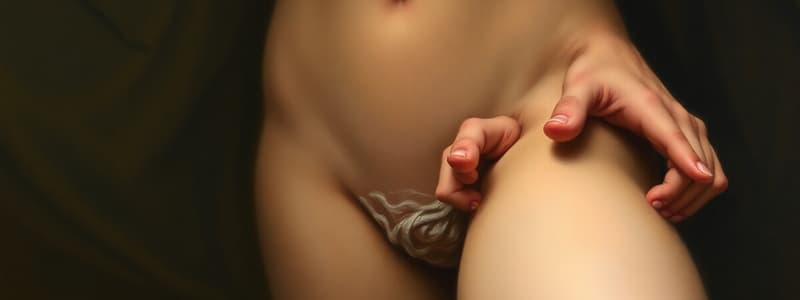Podcast
Questions and Answers
What is the primary mechanism behind stress incontinence?
What is the primary mechanism behind stress incontinence?
- Weakness of the pelvic floor muscles (correct)
- Bladder outlet obstruction
- Loss of cerebral inhibition of detrusor muscle contraction
- Detrusor overactivity
Which type of urinary incontinence most likely involves a combination of different causes?
Which type of urinary incontinence most likely involves a combination of different causes?
- Stress incontinence
- Mixed incontinence (correct)
- Urgent incontinence
- Functional incontinence
Which condition can lead to detrusor overactivity, resulting in urge incontinence?
Which condition can lead to detrusor overactivity, resulting in urge incontinence?
- Limited mobility
- Parkinson's disease (correct)
- Bladder outlet obstruction
- Pelvic floor muscle weakness
In overflow incontinence, which of the following factors can cause detrusor underactivity?
In overflow incontinence, which of the following factors can cause detrusor underactivity?
What type of incontinence is primarily due to cognitive impairments that affect timely toilet access?
What type of incontinence is primarily due to cognitive impairments that affect timely toilet access?
Which statement about stress incontinence is correct?
Which statement about stress incontinence is correct?
What commonly triggers urinary incontinence due to intrabdominal pressure?
What commonly triggers urinary incontinence due to intrabdominal pressure?
Which of the following is NOT a type of urinary incontinence?
Which of the following is NOT a type of urinary incontinence?
Which factor is NOT considered a non-modifiable risk factor for urinary incontinence?
Which factor is NOT considered a non-modifiable risk factor for urinary incontinence?
What type of urinary incontinence is primarily caused by pelvic floor weakness and increased abdominal pressure?
What type of urinary incontinence is primarily caused by pelvic floor weakness and increased abdominal pressure?
Which medication class can negatively impact the bladder's ability to store or release urine?
Which medication class can negatively impact the bladder's ability to store or release urine?
What condition is associated with urge incontinence due to its effect on the nervous system?
What condition is associated with urge incontinence due to its effect on the nervous system?
Which of the following conditions does NOT lead to overactive detrusor contractions?
Which of the following conditions does NOT lead to overactive detrusor contractions?
Which of the following is a modifiable risk factor for urinary incontinence?
Which of the following is a modifiable risk factor for urinary incontinence?
What is the likely cause of overflow incontinence in men?
What is the likely cause of overflow incontinence in men?
What is the primary characteristic of functional incontinence?
What is the primary characteristic of functional incontinence?
What is the primary cause of urge incontinence?
What is the primary cause of urge incontinence?
Which condition is associated with overflow incontinence?
Which condition is associated with overflow incontinence?
Functional incontinence can be described as which of the following?
Functional incontinence can be described as which of the following?
Mixed incontinence is characterized by which of the following?
Mixed incontinence is characterized by which of the following?
What is the nature of urinary incontinence in terms of transmission?
What is the nature of urinary incontinence in terms of transmission?
What effect does obesity have on urinary incontinence?
What effect does obesity have on urinary incontinence?
Which is not a cause of urinary incontinence?
Which is not a cause of urinary incontinence?
Flashcards
Stress Incontinence
Stress Incontinence
Involuntary leakage of urine due to weakened pelvic floor muscles.
Urge Incontinence
Urge Incontinence
Involuntary leakage of urine due to an overactive bladder.
Overflow Incontinence
Overflow Incontinence
Involuntary leakage of urine due to a blocked bladder outlet or weak bladder muscle.
Mixed Incontinence
Mixed Incontinence
Signup and view all the flashcards
Functional Incontinence
Functional Incontinence
Signup and view all the flashcards
Pathophysiology
Pathophysiology
Signup and view all the flashcards
Urethral Sphincter
Urethral Sphincter
Signup and view all the flashcards
Detrusor Muscle
Detrusor Muscle
Signup and view all the flashcards
Disease Transmission of Urinary Incontinence
Disease Transmission of Urinary Incontinence
Signup and view all the flashcards
Obesity as a Risk Factor
Obesity as a Risk Factor
Signup and view all the flashcards
Smoking as a Risk Factor
Smoking as a Risk Factor
Signup and view all the flashcards
High Impact Physical Activity as a Risk Factor
High Impact Physical Activity as a Risk Factor
Signup and view all the flashcards
Study Notes
Urinary Incontinence
- Urinary incontinence is involuntary urine leakage, often due to anatomical, neurological, or functional problems.
- Types include stress, urge, overflow, mixed, and functional incontinence.
Stress Incontinence
- Causes: pelvic floor muscle weakness (often from childbirth, aging, or surgery), increased intra-abdominal pressure (e.g., coughing, sneezing, heavy lifting).
Urge Incontinence
- Causes: detrusor overactivity (bladder spasms), local irritation (e.g., bladder infections), or neurological disorders (e.g., Parkinson's disease, stroke).
- Detrusor overactivity: Involuntary bladder contractions causing a sudden urge to urinate.
Overflow Incontinence
- Causes: bladder outlet obstruction (e.g., enlarged prostate, tumors), detrusor underactivity (impaired bladder emptying, due to nerve damage or medications).
Mixed Incontinence
- Combining stress and urge incontinence.
- Common in older adults.
Functional Incontinence
- Inability to reach the toilet due to physical or cognitive limitations (e.g., dementia, immobility).
Pathophysiology
- Stress: Increased intra-abdominal pressure overwhelms the urethral sphincter.
- Urge: Overactive detrusor muscle contractions.
- Overflow: Chronic bladder overfilling due to obstruction or reduced bladder emptying.
- Functional: Inability to access a toilet in time.
Risk Factors (Modifiable)
- Obesity (increases intra-abdominal pressure).
- Smoking (causes chronic coughing).
- High-impact physical activities (increase abdominal pressure).
- Diet (excessive caffeine or alcohol).
- Medications (diuretics, sedatives).
- Urinary Tract Infections (UTIs).
Risk Factors (Non-Modifiable)
- Age (older age reduces bladder function).
- Gender (women more prone to stress incontinence).
- Childbirth (weakens pelvic floor muscles).
- Neurological disorders (e.g., stroke, MS, Parkinson's).
- Spinal cord injury.
- Prostate enlargement (in men).
Studying That Suits You
Use AI to generate personalized quizzes and flashcards to suit your learning preferences.





